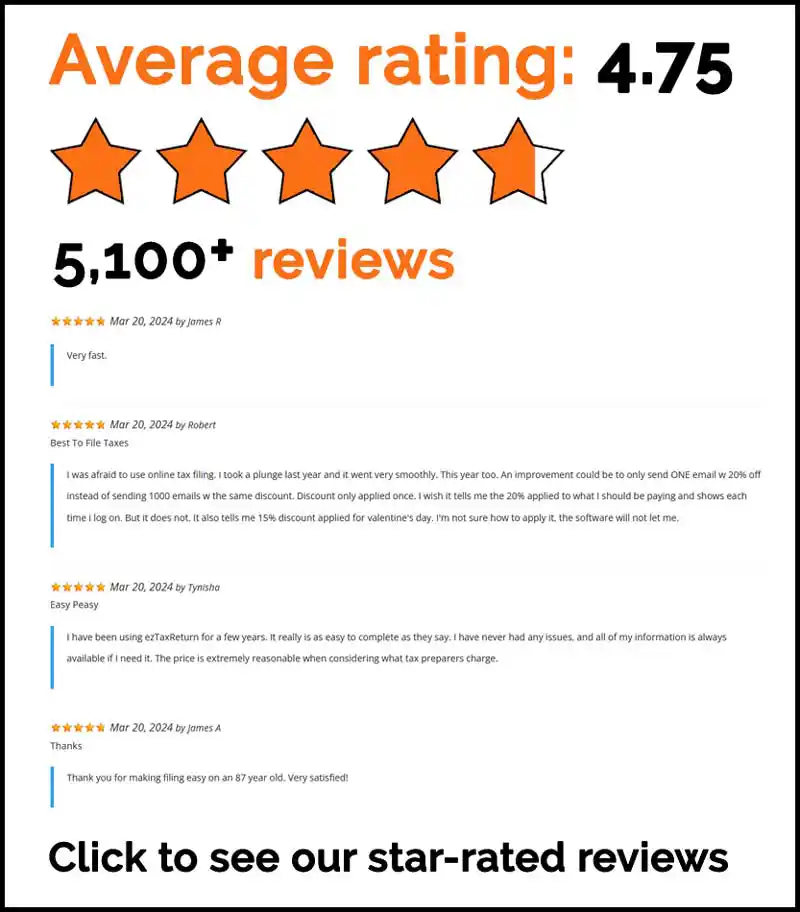The information in this article is up to date for tax year 2024 (returns filed in 2025).
If taxes feel overwhelming, you’re in good company. In fact, Albert Einstein himself once said, “The hardest thing in the world to understand is the income tax.” And no wonder–there are dozens of IRS forms and attachments to fill out, each with its own instructions and varying applicability. These forms can be easily downloaded from the IRS website. This makes keeping track of everything you need to file your return a dizzying prospect for most people.
Now you may be thinking, if Einstein had trouble understanding taxes, what hope do I have? But that’s why we’re here.
There are IRS forms for reporting everything from employment income and investments to qualifying credits. Below we’ll break down the most common IRS forms you may need to file taxes, what they’re for, and when to use them.
Table of Contents
Where to Start
To get started filing your taxes, you will need either Form 1040: U.S. Individual Income Tax Return or Form 1040-SR: U.S. Tax Return for Seniors. To find these forms, enter the form number or description in the search field on the IRS website. These are the standard forms used by taxpayers, regardless of whether you itemize deductions or not. Form 1040 and 1040-SR are nearly identical, except that 1040-SR is designed for taxpayers over the age of 65.
Wondering what forms you need to file taxes? Depending on your specific income and tax situation, you will use other forms and attachments (see below) to accurately report your tax liability and calculate any taxes you may be owed.
Understanding Tax Forms
Navigating the world of tax forms can feel like deciphering a new language, but understanding these documents is crucial for accurate and timely filing of your tax returns. Tax forms are essential tools used by the Internal Revenue Service (IRS) to report income, claim deductions, and calculate tax liability. They come in various types, each serving a specific purpose for individuals, businesses, and organizations.
Tax forms can be broadly categorized into several types:
- Individual Tax Forms: These include forms like Form 1040 and Form 1040-SR, which are used by individuals to report their income and calculate their tax liability.
- Business Tax Forms: Forms such as Form 1120, Form 1120S, and Form 1065 are used by corporations, S corporations, and partnerships to report their financial activities.
- Employment Tax Forms: These include Form W-2 and Form W-4, which are used to report wages and tax withholding information.
- Information Returns: Forms like Form 1099 and Form W-9 are used to report various types of income other than wages, salaries, and tips.
Each tax form comes with its own set of instructions, schedules, and requirements. It’s essential to carefully review these instructions and schedules to ensure you complete the form accurately. Whether you’re an individual taxpayer or a business owner, understanding the specific forms you need and how to fill them out correctly can save you time and help you avoid potential penalties.
Most Common IRS Forms
Here are just a few of the most common IRS forms you may need to fill out with your next tax return:
Form W-2: Wage and Tax Statement
Form W-2 reports an employee’s income earned and tax withholding for the year. This can also include:
- Tips and other forms of compensation
- Contributions to a retirement plan, like a 401(k)
- Cost of your healthcare benefits
Employers use W-2s to report FICA taxes for their employees. Your employer is required to send you (and the IRS) your W-2 by January 31. Most employees need a W-2 in order to begin filing their taxes. If you don’t receive your W-2 on time, contact your employer.
Form W-4: Employee’s Withholding Certificate
Form W-4 tells your employer how much to withhold from your paycheck throughout the year. (You should fill out a W-4 when you start a new job or when you want to adjust the amount currently withheld).
When you file your taxes, the total amount of taxes withheld will be credited to your return. The amount withheld is based on your filing status, dependents, and potential credits and deductions. Use the IRS Tax Witholding Estimator to calculate how much to withhold.
Form W-9: Request for Taxpayer Identification Number and Certification
Form W-9 is used to obtain taxpayer information for non-employees. These forms are most commonly used between independent contractors and companies they are working with. Companies that pay non-employees more than $600 in a calendar year are required to file an information return. They use a W-9 form to collect and record the tax info they will need.
In other words, if you are a freelancer or independent contractor, you will likely need to fill out a W-9. The purpose of a W-9 form is to certify your TIN, confirm you are not subject to tax withholding or claim exemption from backup withholding if you are an exempt payee.
Form 1040: U.S. Individual Income Tax Return
Your 1040 form is the primary tax document you will need to file your federal income taxes with the IRS. It reports your adjusted gross income (AGI)–or the money you made in the past year, minus any applicable credits or deductions–and calculates your tax refund or amount owed.
Most people will file Form 1040, including employees, self-employed taxpayers, or retirees who live off income from investments. Users can enter the form number or title in the search box on the IRS website to find Form 1040.
Form 1040-SR: U.S. Tax Return for Seniors
Form 1040-SR is an alternative Form 1040 for taxpayers age 65 and older. If you were at least 65 by the end of the tax year for which you are filing, you can use either form to file your taxes.
The main difference between Form 1040 and Form 1040-SR is that 1040-SR features larger print and a standard deduction chart with emphasis on senior tax benefits to make it easier for older Americans to read and understand.
Note: You do not have to be retired to use Form 1040-SR.
Form 1040-ES: Estimated Tax for Individuals
Form 1040-ES is for taxpayers to figure and pay their estimated tax. Estimated taxes are paid quarterly to the IRS on income that is not subject to tax withholding.
This means, if you are self-employed or receive income such as interest, dividends, alimony, or capital gains, you may have to make estimated tax payments. Individuals, including sole proprietors, partners, and S corporation shareholders, can use Form 1040-ES to calculate their estimated tax based on expected AGI, taxable income, taxes, deductions, and credits.
Form 1098: Mortgage Interest Statement
Form 1098 is an IRS form used to report mortgage interest during the year. If you pay more than $600 in mortgage interest, your lender will send you a 1098 form. Homeowners can use Form 1098 to figure their mortgage interest deduction on their annual tax return. However, you must be the primary borrower on the loan and actively making payments in order to use the deduction.
Form 1099-NEC: Nonemployee Compensation
Businesses use Form 1099-NEC to report payments made to independent contractors, freelancers, and self-employed individuals. (Prior to 2020, non-employee compensation was reported on 1099-MISC).
If you are self-employed and were paid more than $600 during the year by a company, that company is required to issue you a 1099-NEC by January 31 of the following year. You can then use Form 1099-NEC to fill out your own tax return.
Form 1099-MISC: Miscellaneous Income
Use Form 1099-MISC to report miscellaneous compensation such as rent, prizes and awards, royalties, medical and healthcare payments, and more.
If you receive a 1099-MISC, you can use it to determine how much income you received during the year and what type of income it was. Depending on your situation, the miscellaneous income may not be taxable if it is eligible for deductions or credits.
Form 1099-G: Certain Government Payments
Form 1099-G, is issued by federal, state, or local governments to report payments to you that you may need to include on your tax return. This most commonly includes
- Unemployment compensation
- State or local income tax refunds or credits.
If you receive unemployment benefits, these are subject to taxes. Box 1 on the form will show the total compensation payments for the year. This is the number you will report on Form 1040, Schedule 1.
Business Tax Forms
For businesses, tax forms are a critical part of reporting income, expenses, and tax liability to the IRS. Whether you’re running a corporation, partnership, or sole proprietorship, there are specific forms you’ll need to file to stay compliant with federal tax laws.
Form 1120: Corporate Income Tax Return
Form 1120 is the cornerstone of corporate tax reporting. This form is used by corporations to report their income, gains, losses, deductions, and credits, ultimately calculating their federal tax liability. Here’s what you need to know about completing Form 1120:
To fill out Form 1120, corporations must provide detailed information, including:
- Business Information: This includes the corporation’s name, address, and employer identification number (EIN).
- Income and Expenses: Corporations must report their gross receipts, cost of goods sold, and operating expenses.
- Credits and Adjustments: This section includes items like depreciation, amortization, and research and development credits.
- Tax Liability: Corporations need to calculate their federal income tax, alternative minimum tax, and any employment taxes owed.
In addition to the main form, corporations must attach various schedules and supporting documents, such as:
- Schedule C: Income and Expenses
- Schedule D: Capital Gains and Losses
- Schedule E: Supplemental Income and Loss
- Form 4562: Depreciation and Amortization
Form 1120 is typically due on the 15th day of the fourth month after the end of the corporation’s tax year. For instance, if the corporation’s tax year ends on December 31, the form is due on April 15.
Corporations can download Form 1120 and its instructions from the IRS website (irs.gov). Alternatively, they can request paper forms to be mailed to them by contacting the IRS.
By understanding and correctly completing these business tax forms, corporations can ensure they meet their federal tax obligations and avoid potential issues with the IRS.
Common Tax Form Attachments
As part of your tax return, you may also need to fill out and attach additional IRS forms. Here is a brief list of common attachments:
Where to Send Your Completed IRS Forms
If filing a paper return by mail, you can find the IRS office address for your state here. However, the IRS recommends filing your taxes electronically because it is more convenient and more secure. You can file your taxes free using IRS Free File or through ezTaxReturn.
See the full list of IRS forms and schedules we support.
ezTaxReturn takes the guesswork out of taxes so you can file with confidence. You can file a FREE simple federal return if you have a basic tax situation.
The articles and content published on this blog are provided for informational purposes only. The information presented is not intended to be, and should not be taken as, legal, financial, or professional advice. Readers are advised to seek appropriate professional guidance and conduct their own due diligence before making any decisions based on the information provided.




